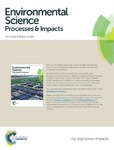Reactivity, Characterization of Reaction Products and Immobilization of Lead in Water and Sediments using Quercetin Pentaphosphate

View/
Date
2016Author
Okello, Veronica A.
Osonga, Francis J.
Knipfing, Michael T.
Bushlyar, Victor
Sadik, Omowunmi A.
Metadata
Show full item recordAbstract
Lead is currently ranked the number one heavy metal pollutant with
maximum contaminant level (MCL) of 0.015 mg/L. The use of organicsolvent
free methods to immobilize lead from the environment is attracting
the attention of scientists and environmental engineers. This study reports
the application of water soluble Quercetin pentaphosphate (QPP), a
derivative of quercetin, for the detection and immobilization of Pb2+ from
water and soil samples. The techniques employed include UV-visible,
fluorescence, atomic absorption; inductively coupled plasma optical
emission and Fourier transform infrared (FTIR) techniques. Results indicated
the formation of QPP-Pb complex that inhibits fluorescence intensity of the
parent molecule. The fluorimetric limit of detection was found to be 3.46 X
10-4 M. The QPP-Pb complex exhibited a corresponding stoichiometry with
the predominant complex of PX2. A Scatchard plot of y = -4*106x + 2916.3
was observed with a negative slope giving an equilibrium constant of 4x106
M-1 and 5.4*105 M-1 in acidic and alkaline conditions respectively. Results
show 90.4 % and 91.5 % lead (II) immobilization from BRS and BU soil
samples respectively. On the other hand, 91% lead immobilization efficiency
from water sample was achieved at room temperature and is in compliance
with MCL level of 15ppm at ~ 3.82% error margin. This approach does not
require the use of organic solvents or the disposal of large amounts of
sludge. Once complexed with lead, QPP may not release phosphate to cause
any secondary pollution.
Key Words: Quercetin Pentaphosphate, lead, immobilization, organicsolvent-
free and complexes
